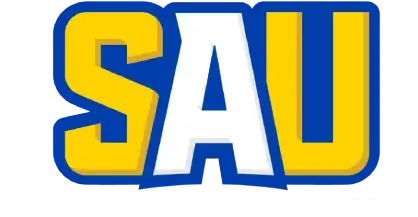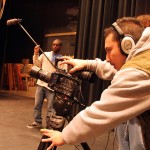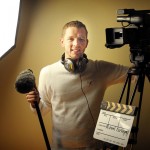The next breakthrough big-screen blockbuster film director could be a Southern Arkansas University Mulerider, according to SAU’s Digital Cinema professor Marek Dojs.
“Technology has leveled the playing field for filmmaking,” said Dojs. “People no longer need to go to Hollywood to make films – they can do it in Magnolia, Ark. For all we know, the next Steven Spielberg could be learning their trade here at SAU.”
The odds of that happening are ever-increasing, as the number of students entering the exciting Digital Media Production is shooting up. SAU is nurturing this ever-expanding major by providing funds for student film-making equipment that could easily be seen on a set in L.A. and constructing a video-editing lab with double the current capacity and four times the current storage space.
The program was created in 2007 as Digital Media Productions to respond to the growth of the film industry in the region as Shreveport becomes one of the country’s hot-spots for film production. Dojs took the reins in fall 2010, and was given permission to redesign and provide a clearer focus for the program.
“Today the program has a cinematic focus,” said Dojs. “We begin teaching students the basics of visual storytelling and move towards making strong short films, all the while infusing theory and criticism into their production experiences. As a documentary filmmaker myself, I am excited to work side-by-side with these young filmmakers as they make this journey.”
As passionate students started to be drawn to Southern Arkansas to learn the art of digital storytelling, universities’ marketing departments were also starting to understand the power of video. The SAU Communications Center was no different.
“With a background in visual storytelling as a photojournalist and being an SAU alum myself, I knew that SAU could improve the way its ‘Complete College Experience’ campaign was being told through staged video shoots by visiting commercial producers,” said Aaron Street, SAU director of communications. “But I knew that I could not do it alone.”
Street soon had produced a TV spot for the University, at when previewed for the administration; he was given the thumbs-up for funding to purchase a video camera, video-editing hardware and software and student-worker funds.
“I had heard the name ‘Melissa Heard’ buzzing about as a student with an eye for video-production,” said Street. “I found her phone number, so I called and offered her a job as my video assistant before we hung up.”
Heard had already developed quite a following on YouTube, a following which had recently shot up because one of her music videos beat out thousands of online entries in one of the website’s popular video competitions. To date, her “Digital Munchies” YouTube page has more than 30,000 subscribers and more than 4.5 million total video views.
With Street’s storytelling experience and Heard’s speed and savvy editing skills, Southern Arkansas University’s YouTube presence quickly started to grow.
“Before I knew it, we had the most popular higher education YouTube page amongst the Arkansas universities,” said Street. “I knew that this venture was producing good PR for SAU, but I also realized the great learning experience it was for me and Melissa.”
Heard’s experiences with video date back to when she was just five years old.
“I loved the idea of being able to produce my own shows and play them back on the television,” said Heard. “Growing up, I became familiar with the pre-digital, limited technology available in the ‘90s. When I was in high school and first experienced digital video editing, and I fell in love. I began making music videos, then started writing, directing and editing my own short films. When I found out that SAU was offering the new Digital Media major, I knew it was what I was meant to do.”
Heard studied primarily under the program’s initial professor, Daehwan Cho, who she credits with providing a “well-rounded understanding of the digital media spectrum, great opportunities to participate in local projects and opportunities to showcase her work.”
Under Dojs, she says she learned “a great deal about the structure, organization and execution of production plans.” She credits art professor Dan May with getting her acquainted with graphic design and animation programs. And she says she was lucky to be one of the few to get a job directly relating to her field of study while still in college.
“My experience working in the Communications Center was an extremely important part of my college career,” said Heard. “Having a hand in filming and editing the school’s video projects has given me strong resume credits and a solid understanding of how to target audiences.”
While telling the story through video of SAU’s Complete College Experience, she too took full advantage of her time in and out of the classroom at SAU. At the beginning of her senior year, she was hired as editor of The Bray, Southern Arkansas’ student newspaper. Between working late nights in the newsroom, going to class during the day and producing videos for class projects, for SAU communications and for her own creative expression, she earned her diploma and the top undergraduate award for the graduating class from the College of Liberal and Performing Arts. She is currently splitting her time behind and in front of the camera – chasing the dream of being on the big screen under representation with an agent in New Orleans while opening MH Video & Photography, LLC., which she plans to operate in the ArkLaTex.
By the time Heard walked across the stage for her diploma, the demand for SAU Communications Center videos had increased tenfold. Her seat at the editing desk did not stay vacant long, as a passionate Digital Cinema students Abhishek Dixit and Michael Kornegay were anxious to help produce SAU videos.
Dixit grew up in Kathmandu, Nepal. Like Heard, he knew at an early age that he wanted his work to been seen on screen and bring smiles to the masses.
“Every Saturday, the TV broadcasted movies and everyone tuned in,” said Dixit. “After watching the Saturday movies, I would analyze them and think of ways they could be made better. My parents recognized my interest in film early on and supported me. Plus, it was a good excuse for me to be allowed to watch more TV.”
His parents also supported his brother’s passion with computers, so they bought the family a P.C. despite computers’ hefty price tags at the time. So when it came time for Dixit to think about college, he surfed the web and started a list of affordable universities with film programs. He said he chose to become a Mulerider because of the communications department, the Honors College and the scholarship opportunities.
Dixit has made the most of his opportunities here by staying busy making documentaries, and not just those for class credit. His first was to promote Southern Arkansas’ supplemental instruction program. He has also produced videos for multicultural services and other creative ventures.
“I am actually making a movie on my own in which I am incorporating all mediums of art,” said Dixit of the story he wrote, composed music for with his guitar, is directing and editing. “Looking back at my dreams of making movies, I know now I have placed myself in the right path to pursue this as a career. I can really say I am proud to be a part of the Digital Cinema program at SAU.”
Kornegay, 22, of Hot Springs, was drawn to SAU because of the people and the family-like atmosphere. He has certainly made his mark in his four years here, being awarded Freshman of the Year in 2008, getting a Mulerider Leadership award three years, President of ReaLife for two years, elected to the Student Activities Board, student assistant for the dean of students and an Upward Bound peer counselor.
It is no surprise that he was drawn to the Digital Cinema program because it offers new experiences every day and the opportunity to meet new people.
In fact, it was his personality that helped him land an internship with Little Rock’s KATV Channel 7 for the summer of 2012. During the stations annual visit to SAU’s homecoming pep rally, Kornegay introduced himself to the crew and jumped right in to help as a grip. From that experience, he made a contact at the station and the rest is history.
“I was excited about telling professor Dojs about landing an internship at KATV because he loves to see students succeed,” said Kornegay. “I may have come to SAU because I felt at home, but the variety in courses and the hands-on experiences professor Dojs has created for us has given me the skills to feel comfortable working at KATV this summer, working in a large network as a career or running my own freelance business one day.”




